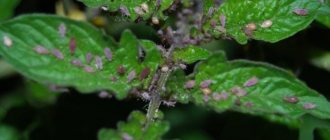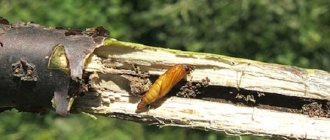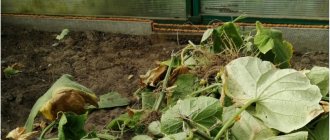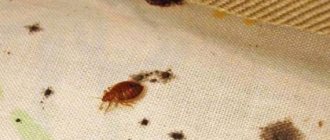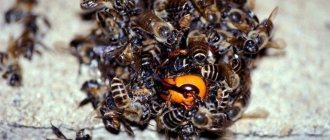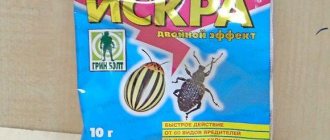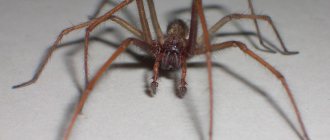What does a tomato scoop look like: photo
Scoop on tomatoes.
Natural enemies of the cutworm
Birds peck the scoop from tomatoes, so in winter the birds need to be fed, and in summer they need to be attracted to the site in every possible way.
Butterflies have their own parasites:
- bracon;
- black banhus;
- tachina fly.
There are Trichogramma on sale - egg-eating insects that parasitize the cutworm. Their use is especially effective on tomatoes in greenhouses. They find a clutch of armyworms and release their own eggs inside. Trichogramma are less prolific than the pest. But they give 2-3 generations per 1 generation of armyworm.
Description of tomato scoop
Name: Tomato cutworm or carandrina Lat.:
Laphygma exiguaClass: Insects - Insecta Order: Lepidoptera - Lepidoptera Family: Noctuidae
| Habitats: | everywhere, all over the world |
| Dangerous for: | polyphagous pest, more than 30 plant species |
| Means of destruction: | folk, chemical and biological preparations |
Tomato scoop.
The wingspan is up to 2.4 mm. The forewings are gray-brown with transverse double smooth lines. There are 2 spots on the wings. The brownish spot is kidney-shaped. A round speck of a rusty-orange hue. The hind wings are white. They have a slight pink coating.
The eggs are yellow-green. Diameter 0.5 mm. The larva is from 2.5 cm to 3 cm in length. The color can be either green or brown. There is a wide dark stripe on each side, with yellowish stripes underneath it. The abdomen is lighter with white spots. The pupa is yellowish-brown. Length up to 14 mm.
How to detect tomato cutworm in time
You can recognize the tomato moth by its appearance based on the following signs: it is a butterfly with a wingspan of 23-24 millimeters, the front pair of which are noticeable with a grayish-brown color. Transverse blurred double lines are visible. The kidney-shaped spot has a brownish tint. The round spot is rusty-orange in color. A pair of hind wings is white with a pinkish tinge. If you notice one at dusk, expect its harmful offspring on your green and brown tomatoes.
Unfortunately, we find this insect already in the caterpillar stage in our holey and spoiled tomatoes. And such a caterpillar looks like this: length 25-30 millimeters; color varies from green to brown. The back is decorated with thin longitudinal hairy lines; on the sides there is a wide dark line above a light yellow stripe. The ventral side is light.
When storing even green tomatoes, you first find its excrement, and then you urgently look for the insidious hole and this green-brown “habitation” in it. If you hesitate, this insatiable insect will “bite” and make holes in more than one tomato... However, it’s a shame...
Life cycle
Butterflies
The flight of butterflies occurs from May to the end of October. 1 - 3 days after departure, females lay eggs. Over the entire life cycle, it can lay up to 1,700 eggs. The first generation butterfly is the most prolific.
Eggs
A clutch of eggs consists of three to four piles, each of which contains 250 eggs. Laying sites are the underside of weed leaves. The shelter is grayish hairs that the female sheds from the abdomen
Caterpillars
Egg development takes from 2 to 10 days. This period is affected by temperature. Caterpillars develop in 2 to 4 weeks. Young individuals feed on weeds, while older individuals feed on cultivated plants. They make holes in the leaves and leave behind veins.
Pupae
The caterpillar pupates in the ground. The depth is usually from 3 to 5 cm. The pupa is formed in one to four weeks.
Control of butterflies and cutworm larvae
Work to remove armyworms should not be limited to the destruction of caterpillars; measures must also be taken against adult butterflies and pupae. Only complex action against the pest at all stages of development can completely expel the insect from the site.
Fighting an adult
When armyworms are found on a plot of land, the gardener’s task is to prevent the insect from laying eggs on the plantings. For this use:
- Traps. Butterflies are lured to fermented drinks (beer, kvass, syrups, juices), containers with which are placed on the site.
- Breeding predatory insects that feed on cutworms. These include Trichogramma and Bracon. You can purchase such helpers on special farms.
- Repellent. If you need to quickly respond to the appearance of armyworms, you can scatter eggshells between the rows. When planning protection in advance, it is worth planting plants near the planting of tomatoes and other potentially vulnerable crops, the smell of which repels the pest. These are cilantro, basil, calendula.
- Treatment with infusions. Folk remedies, especially those with a pronounced aroma (infusion of onions or onion peels, cloves or arrows of garlic, mustard powder, tobacco powder) will also scare the butterfly away from landing.
Destruction of larvae
Armyworm larvae are quite large, so some of them can be collected by hand when digging the area. But it is impossible to completely select insects, especially from a large planting. It is worth resorting to additional methods of struggle:
- Raising the lower layers of soil. After harvesting, you should dig the area deeply. It is necessary to turn over the layers of soil at a depth of 25-30 cm - most of the pupae hide at this level and will die from the cold once on the surface. The same procedure is repeated in early spring to destroy pests that have survived the winter.
- Attracting birds. Tits, flycatchers, and sparrows readily eat larvae of the noctuid moth.
- Chemical soil treatment. Insecticides are used against soil pests. Gardeners call “Bazudin” among the most effective against cutworms.
Habitat
Carandrina inhabits a huge area, distributed throughout almost the entire territory of temperate and subtropical climates. Most often, the cutworm inhabits tomatoes:
- the European part of the Russian Federation;
- Southern Siberia;
- Urals;
- Far East;
- Baltic;
- Belarus;
- Ukraine;
- Moldova;
- Kazakhstan;
- Central Asia;
- China;
- Southern Europe;
- Africa;
- Australia;
- America.
Harm of cutworms
The potential fertility of the cutworm is 2 thousand eggs. It is especially unpleasant that some species lay one butterfly per leaf, and one butterfly can infect a huge area. Other cutworms can leave 300 or more eggs on the underside of a tomato leaf blade.
Butterflies do not pose a danger to tomatoes, and even bring some benefit by participating in pollination. The pests are larvae that live quite a long time.
If in the south their development can last 2 weeks, then in the northern regions the caterpillars of the Winter Armyworm sometimes feed for up to 100 days until they pupate.
During the day, the larvae hide under leaves or plant litter, and feed in the evening and at night. Cutworm - crop pests are conventionally divided into three groups:
- leaf-eaters, whose food base is tomato leaves;
- gnawing cutworms damage the roots and lower part of tomato shoots, most belong to the Agrotis subfamily;
- intrastem ones gnaw into soft tissue, live and feed inside the plant until the time comes to pupate.
But it’s not for nothing that moths are called omnivores. Caterpillars in the early stages of development usually skeletonize and gnaw tomato leaves. Then they may well move onto tomato fruits, damaging them in the area of the stalk.
Gnawing cutworms prefer not to rise high; they feed on flowers and tomatoes if they lie on the ground.
Caterpillars of the first and second groups damage tomato fruits only when they spread strongly. If the beds and greenhouses are treated, their “activity” will, although it will affect fruiting due to inhibition of bush growth, but only a few ovaries will be eaten away.
Preventive measures
Following simple rules will help avoid pest invasion. To do this you need:
- regularly inspect leaves and stems;
Cutworm caterpillar on tomatoes.
- remove weeds;
- digging up the soil in autumn and spring helps destroy pupae;
- plant calendula, basil, cilantro - they cannot stand the smell;
- remove plants and fruits that have been damaged by caterpillars.
Why does cutworm appear on tomatoes?
In everyday life, the cutworm is also called the moth. This insect belongs to the order Lepidoptera and is very similar in appearance to an ordinary moth. Pests spend the entire fall, winter and spring in the pupal phase, hidden in the upper layers of the soil. With the onset of summer, a butterfly emerges from the pupa.
The main reasons for the appearance of this pest on the site include:
- lack of autumn digging of the soil, as a result of which many insect pupae survive;
- a large number of weeds in the garden, which serve as food for the larvae;
- lack of soil disinfection before planting tomatoes;
- the remains of last year's plants in the soil can also contain pest pupae;
- improper disposal of plants and fruits damaged by larvae.
The insect is small in size and gray in color, the wingspan does not exceed 4.5 cm. 5 days after emergence, the butterfly lays eggs on the leaves of tomatoes, from which small caterpillars hatch after about a week. Their length does not exceed 3 cm, and the color is predominantly green, but there are also pink or brown varieties. It is the cutworm caterpillars that cause irreparable damage to tomatoes and other vegetables in the garden.
Important! Within 2-3 weeks, cutworm larvae eat everything nearby - from the leaves of tomato bushes to the tomatoes themselves.
After the transformation from caterpillar to adult butterfly, the process repeats from the beginning.
In nature, there are several main types of cutworms:
- linen (gamma) — the butterfly has a characteristic pattern on its wings in the form of the Latin letter of the same name, the caterpillars are green with yellow stripes on the back. Gamma cutworm larvae eat not only the leaves of ornamental and cultivated plants, but also the foliage of bushes and trees;
- winter - butterfly wings have a pattern of spots and stripes, caterpillars are gray with a shiny greenish tint. They feed on corn seeds, weeds and young plant shoots in the garden;
- cereal - the wings of butterflies are variegated, they combine gray and brown colors, caterpillars have a brown-gray color with a yellow stripe on the back. They feed on grains and perennial grasses;
- gnawing — on the wings of butterflies a pattern in the shape of an exclamation mark is clearly visible, the color is gray, brown or dark brown. The caterpillars are gray with a yellowish tint and have an orange head. They feed on grains and vegetables, as well as ornamental plants;
- greenhouse — butterflies have a light gray color, spots of various shapes are clearly visible on the wings, the larvae are gray with a dark stripe on the back. Pests feed on the leaves and fruits of all plants nearby;
- cotton - butterflies are yellowish-gray in color with dark gray stripes and spots; the larvae can be white, green, yellow or black. Cotton bollworm caterpillars eat all types of plants;
- agrippina - butterflies are beige or light gray with an intricate pattern on the wings, caterpillars are green with black spots and light stripes on the sides. The pest eats the leaves of legume plants;
- pine — butterflies have variegated wings (from white to brown) with spots and lines of various shapes, caterpillars are green with a wide white stripe. The larvae eat pine needles, young shoots and buds;
- garden (garden) — these include tomato, potato and cabbage scoops. Butterflies are dark or gray in color, while the larvae are predominantly green or gray. They eat leaves and fruits of cultivated plants.
Ways to control cutworms on tomatoes
There are several ways to deal with the pest. They are represented by chemicals, biological methods or folk remedies.
Chemical and biological methods
When a large number of caterpillars appear, Lepidotsid, Agravertin, Aktofit, Fitoverm are used. All drugs belong to hazard class 4. Biological compounds are quickly eliminated.
Among chemical preparations, preference is given to Inta-Vir, Decis, and Avant. The withdrawal period for pesticides is at least a month.
One of the disadvantages is that the chemicals are absorbed into the soil and tomatoes. The expected start of the harvest is calculated in advance.
Traditional methods
Among the large number of methods of struggle, taken from the experience of the people, there are several of the most effective.
You can use garlic. The head is cut and placed in a container with boiling water (1 l). Leave for 3 days. Strain. Pour water into a bucket. The solution is ready for use.
Wormwood can cope with the pest . The third part of the bucket is filled with it. Pour water. Next you need to boil for 30 minutes. After 2 days, strain and dilute in water in a ratio of 1:10.
is very often used . 0.3 kg is poured into 10 liters of hot water. After a day, the plants are sprayed. And the mixture with lime is used for dusting.
It is advisable to add laundry soap to any solution. The soap makes the mixture sticky and sticks to the plants.
To choose a reliable method of protection, it is better to familiarize yourself with 6 ways to combat cutworms.
Armyworm - photo and fight against it on tomatoes, potatoes and cabbage
Cutworms are small, cute, faded-colored butterflies that resemble house moths; there are various species in nature. And they do no less harm. True, they do not feed on wool and homemade products, but on plants in the garden. Adults do not damage crops, but they hatch caterpillars - the main danger to crops.
If you want to preserve your harvest, begin measures to destroy and prevent the appearance of this pest. Below are the measures to combat it further.
What is a cutworm
The cutworm belongs to the order of Lepidoptera insects. This butterfly has a color from milky to dark brown or gray. Its wingspan is 30-50 mm. The wings and body are covered with fluff; it looks very much like a moth.
There are many varieties of these pests. Tomatoes are most often attacked by cotton bollworms.
The cutworm larva is a green or brown caterpillar 30 mm long. It is the caterpillars that pose the greatest danger to the garden. They eat everything that comes their way: stems, leaves, fruits and even roots, while butterflies feed exclusively on nectar.
Cutworms live for two months: the caterpillar phase lasts 40 days, and the butterfly phase lasts 2-4 weeks.
During the day, both caterpillars and butterflies hide, they are active at night, so they are difficult to detect. And throughout the summer, new generations constantly appear.
The plant reacts very painfully to insect attacks and soon dies. Therefore, the question of how to protect tomatoes from the cutworm is quite complex, but solvable.
Important ! The danger of the pest is that it feeds not only on tomatoes. Beans, corn, eggplants and other garden crops are susceptible to attack.
Signs of appearance
If you notice these signs on plants, you must immediately take action:
- small holes in the leaves that get larger over time;
- holes in fruits;
- clusters of white round eggs on leaves;
- the appearance of green caterpillars on the plant;
- damaged ovaries or buds.
How to defeat a pest
But in no case should you despair, because nowadays you can purchase many effective drugs to combat harmful insects, including the cutworm.
So, if pests are found on tomatoes in small quantities and in a timely manner, then it is worth trying to start fighting them using traditional methods:
- With the onset of a new decade, spray tomato bushes with an infusion based on garlic arrows.
- An infusion of wormwood, which is recommended to treat tomatoes once a week, has also proven itself to be excellent in the fight against cutworms.
To prepare the infusion, you will need to prepare 300-400 g of wormwood, chop it and boil over low heat for half an hour. Next, the broth is filtered, diluted with 15 liters of water and used to spray tomatoes.
- No less effective is a decoction that contains the following ingredients:
- tobacco or shag;
- celandine;
- sagebrush.
The ingredients are taken in equal quantities so that the total weight is 500 g. All components are thoroughly mixed in 15 liters of well-heated water, half a glass of chopped garlic is added, and the broth is left to infuse for about a day. After infusion, each bush is carefully sprayed with the decoction, special attention is paid to the leaves and soil near the cultivated planting.
Regular destruction of weeds and planting calendula around planting beds will become an obstacle to the development of larvae of the crop pest.
Prevention of occurrence
To prevent cutworms from appearing on your property, take a number of preventive measures:
- Remove weeds regularly – cutworms like to lay eggs on nearby weeds, especially flowering species, as they attract butterflies.
- Plan your site - do not plant tomatoes next to your favorite cutworm crops: beans, potatoes, sweet peppers, corn, eggplants. Scoops do not like garlic and onions.
- Loosen the soil - the caterpillars end up on the surface of the ground, which negatively affects them.
- Carefully clean and dig up the area in the fall.
- Inspect your plantings regularly for any changes.
Means of struggle
Biological drugs
They are divided into 2 groups - bacterial and avermectins . Bacterial agents contain microbial toxins with a neurotoxin effect on pests.
- Dendrobacillin. A bacterial agent that is effective against cutworms and safe for humans. Consumption rate: 25-30 g per bucket of water. You can do up to 2 treatments per season.
- Bitoxibacillin. A product of bacterial activity that inhibits the production of digestive enzymes disrupts intestinal function. In addition, it has a negative impact on all subsequent generations of the moth. The consumption rate is quite economical - about 20 ml of product per hundred square meters, first diluted in a bucket of water.
- Lepidocide. A bacterial agent that acts against any leaf-eating caterpillars, including cutworms. The consumption rate is 25-35 g per bucket. Enough to process 1-2 acres.
- Entobacterin. Microbiological remedy for leaf-eating caterpillars. The consumption rate is 3.5 kg per hectare of area.
- Fitoverm . Bacterial preparation against many pests, including all types of cutworms. Consumption depends on the type of crop being treated and ranges from 1 to 4 ml per bucket of water.
- Agravertine . A product obtained from fungi. It has a long shelf life, is safe for people and the environment, and works against most pests. Consumption: 3 ml of product per liter of water.
- Aktofit . An innovative product from the avermectin series. Consumption 4 ml per 1 l.
- Nature Guard . An insecticide from the Sophora plant with neurotoxin properties. Causes paralysis of limbs and death of pests. Consumption: 10 ml, diluted in 5 liters of water.
Chemicals
They are divided into neonicotinoids, organophosphorus compounds and pyrethroids. Modern products of the latest generations often have a combined composition.
Read more about folk methods of struggle.
exclamation scoop
Let's start looking at who the scoops are, with such a representative as the exclamation scoop. Another name for it is exclamation bat.
What does it look like and what is the harm?
A small butterfly with yellow-gray or brown-gray wings. It has a longitudinal black stripe on its wings, similar to an exclamation mark. This feature gave the butterfly its name. Wingspan 3.5–4.6 cm.
The caterpillar is yellow-brown, with a white line on the back and dark stripes on the sides. The butterfly itself is harmless. But the caterpillar devours the fruits and plants on which it lives - potatoes, tomatoes, sunflowers, all vegetable crops, especially carrots. Caterpillars spend most of their lives in the ground and damage plant roots. One individual can damage 10 plants overnight. The larvae, which appear in August-September, feed on winter crops.
Read also: Cortaderia: cultivation, planting and care, photo
How to fight
The basis of the struggle is to choose folk and traditional methods:
- weeding between rows and killing weeds;
- the use of pheromone traps and bowls with bait (jam, beer);
- in the fall, when digging, collect and destroy cutworm caterpillars;
- During the flight of butterflies, spraying with insecticides (Decis, Evrodim, Akiba) helps.
Protecting tomatoes from cotton bollworm pests
Cotton bollworms are pests that cause damage to tomatoes both in the greenhouse and in the open ground. What characteristic signs can be used to say that tomato fruits are damaged by bollworm caterpillars?
The adult insect is a gray-yellow butterfly, its future caterpillars are polyphagous pests that, in addition to tomatoes, damage peppers, eggplants, corn, beans, sunflowers, even tobacco and many other crops - more than 120 species.
The pest overwinters in the soil in the pupal stage. In early June, butterflies hatch from the pupae, and after 3-4 days they lay scattered pale yellow eggs on the leaves, stems and other parts of tomatoes or other cultivated plants. Depending on the temperature, the caterpillars can hatch as early as the third day. The development of the caterpillar lasts from 13 to 22 days.
As you can see in the photo, these tomato pests first damage the leaves, then the buds and flowers:
Cotton bollworms also cause great harm to peppers and eggplants, penetrating into their fruits, and in beans they eat leaves and seeds in beans, and in corn they eat the cob.
The appearance of these pests on tomatoes coincides with mass flowering and the formation of the first fruits, approximately in the first ten days of June. However, usually the emergence of cotton bollworm butterflies lasts for a month or more, so the appearance of one generation subsequently overlaps with another, and the years continue without interruption until October, until frost “kills” the tomatoes. This feature of the development of the cotton bollworm creates certain difficulties in protecting crops from the pest.
To protect tomatoes from these pests, the following measures must be taken:
it is necessary to regularly destroy weeds, starting in spring, in order to reduce the food base of butterflies and caterpillars; It is important to observe the timing of chemical treatments: inspect the beds with tomatoes during the period of mass flowering and at the beginning of fruit set. To combat these tomato pests, when eggs or caterpillars are detected, you need to spray the plants with one of the following drugs: Tsitkor, Decis, Inta-Vir, Iskra, Leptotsid, Kinmiks, Konfidor; be sure to repeat spraying with one of the above-mentioned insecticides after 7 days, since the hatching period of the caterpillars is extended, and the waiting period must be observed; During the period of ripening and harvesting, only biological preparations can and should be used
Carry out at least two to three treatments to control these tomato pests at weekly intervals; Be sure to destroy all plant debris and fruits damaged by the cotton bollworm in the fall, and thoroughly dig up the area occupied by nightshade vegetable crops in order to reduce the number of wintering pupae.
